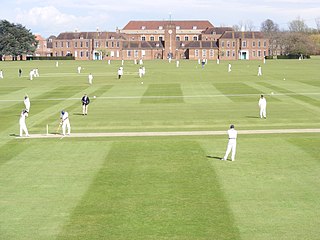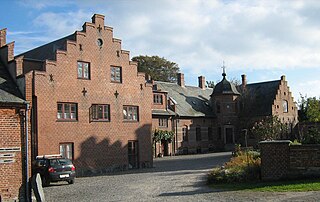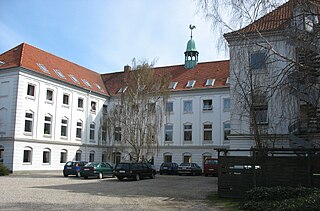Denmark
The Danish continuation schools (Danish: Efterskole ) cover 8th to 10th forms and comprise a broad range of school types. The schools specialize in different educational themes or specific youth-groups. Typical examples are sports, outdoor activities and various creative arts productions. Many continuation schools in Denmark are boarding schools and a stay is normally privately funded by school-fees.
The majority of attending pupils have chosen a continuation school after having finished their elementary school programs at the 9th form. The admission to continuation schools has increased in the 2000s and the association of Danish Industry has criticized this new development as too costly for society, and a waste of a full year during a labor shortage. [1] [2]
A few continuation schools in Denmark deal specifically with young people with a troubled or criminal history. Disciplinary precautions are somewhat limited, with restraints and physical interactions not allowed. In some cases this has resulted in up to between 25 and 33 percent of the youth being expelled during a year at some schools. [3] A single incident (January 2000) led one school to expel 23 percent of its students at once. [4] Most of these continuation schools incorporate therapy and are similar to therapeutic boarding schools, but this concept is not known in Denmark.
Lately, some families who have immigrated to Denmark and have little understanding for the highly developed Danish youth culture are seeking strict orthodox Christian continuation schools for their children. [5] The number of teenagers placed at these schools seemed to have been increasing since the Danish government took action against re-educational stays in the originally homeland. For a number of years Efterskoleforeningen (the association of Continuation Schools) have tried to target this parent-group with an offer to detain their children and keep them "safe" from the challenging parts of the regular youth culture. [6] In 2010 the Danish government announced, that they would reduce the grants for students so the parents would have to pay a larger percentage of the cost for having a child attending the schools. A massive press campaign launched by Efterskoleforeningen inspired the government to adjust the grant-cuts slightly. [7]

Private schools in the United Kingdom are schools that require fees for admission and enrollment. Some have financial endowments, most are governed by a board of governors, and are owned by a mixture of corporations, trusts and private individuals. They are independent of many of the regulations and conditions that apply to state-funded schools. For example, the schools do not have to follow the National Curriculum, although many such schools do.
Truancy is any intentional, unjustified, unauthorized, or illegal absence from compulsory education. It is a deliberate absence by a student's own free will and usually does not refer to legitimate excused absences, such as ones related to medical conditions. Truancy is usually explicitly defined in the school's handbook of policies and procedures. Attending school but not going to class is called internal truancy. Some children whose parents claim to homeschool have also been found truant in the United States.

Education in Sweden is mandatory for children between ages 5/6 and 15/16 depending on when in the year they were born. The school year in Sweden runs from mid–late August to early/mid–June. The Christmas holiday from mid–December to early January divides the Swedish school year into two terms.
A gap year, also known as a sabbatical year, is a period of time when students take a break from their studies, usually after completing high school or before beginning graduate school. During this time, students engage in a variety of educational and developmental activities, such as traveling, working, volunteering, or taking courses. Gap years are not limited to a year-long break and can range from several months to a few years.
Education in Denmark is compulsory for children below the age of 15 or 16, even though it is not compulsory to attend Folkeskole. The school years up to the age of fifteen/sixteen are known as Folkeskole, since any education has to match the level offered there. About 82% of young people take further education in addition to this. Government-funded education is usually free of charge and open to all. Denmark has a tradition of private schools and about 15.6% of all children at basic school level attend private schools, which are supported by a voucher system.
The Danish gymnasium offers a 3-year general academically-oriented upper secondary programme which builds on the 9th-10th form of the Folkeskole and leads to the upper secondary school exit examination. This qualifies a student for admission to higher education Preparatory, subject to the special entrance regulations applying to the individual higher education programmes. Colloquially, gymnasium refers to what is formally called STX.
The Higher Preparatory Examination is a 2-year general upper secondary programme building on to the 10th form of the Folkeskole and leading to the higher preparatory examination, which qualifies for admission to higher education, subject to the special entrance regulations applying to the individual higher education programmes.

A reform school was a penal institution, generally for teenagers, mainly operating between 1830 and 1900. In the United Kingdom and its colonies, reformatories were set up from 1854 onward for children who were convicted of a crime, as an alternative to an adult prison. In parallel, industrial schools were set up for vagrants and children needing protection. Both were 'certified' by the government from 1857 onward, and in 1932, the systems merged and both were 'approved' and became approved schools.
Tenth grade is the tenth year of formal or compulsory education. It is typically the second year of high school. In many parts of the world, students in tenth grade are usually 15 or 16 years of age.
Expulsion, also known as dismissal, withdrawal, or permanent exclusion, is the permanent removal or banning of a student from a school, school district, college, university, or TAFE due to persistent violation of that institution's rules, or in extreme cases, for a single offense of marked severity. Colloquialisms for expulsion include being kicked out of school or sent down. Laws and procedures regarding expulsion vary between countries and states.
Herlufsholm School is a private day and boarding school by the River Suså in Næstved, about 80 kilometers (50 mi) south of Copenhagen. Herlufsholm was founded in 1565 as a boarding school for "sons of noble and other honest men" on the site of a former Benedictine monastery from the 12th century.

Malling is a village in Denmark, located about 12 km (7.5 mi) south of Aarhus. It has a population of 6,194 (Jan 1, 2020).

Langkaer Gymnasium - STX, HF & IB World School was a secondary school and gymnasium in Tilst, Denmark. The school opened in 1975 and effectively closed in 2018 when it merged with Aarhus Tech.
MacGregor High School is a continuation high school located in Albany, California, United States. It is part of the Albany Unified School District.
Naale Elite Academy is an international program jointly funded by the Israeli Ministry of Education and the Jewish Agency. It enables Jewish teenagers from the diaspora to study and complete their high school education in Israel for free.
Community Day Schools in California are operated by school districts. Community day schools serve students referred by a School Attendance Review Board, and other high-risk youths. Community day schools are a type of opportunity school. Community Day schools should not be confused with County Community Schools which are run by County Offices of Education, and serve students who have been expelled from a school district within the county.

Rødkilde Højskole is a folk high school just south of Stege on the Danish island of Møn. Founded in 1866, it is one of the older folk high schools in Denmark. Renamed Teaterhøjskolen Rødkilde, it now offers both short and longer courses for those wishing to learn more about the theatre, especially those aspiring to become actors. The main building by Ludvig Fenger, the student wing and the octagonal assembly building were listed on the Danish registry of protected buildings and places by the Danish Heritage Agency on 8 July 1982.

An efterskole is a unique type of Danish voluntary independent residential school for young people between the age of 14 to 18. At an efterskole, students can choose to spend one, two or three years finishing their primary education, and currently some 28,500 students attend one of approximately 260 such schools throughout Denmark. The schools are open to students from abroad.
The 2011 Præstø Fjord dragon boat accident occurred on February 11, 2011, north of Præstø, Denmark. The incident involved 13 students and two teachers from Lundby Efterskole - a local continuation high school. The boat capsized due to the wind. This incident killed one of the teachers and injured most of the students, leaving several of them in permanent care. The body of the teacher, who was not wearing a lifejacket, was found over seven weeks later on April 3.
Somalis in Denmark are citizens and residents of Denmark who are of Somali descent.






